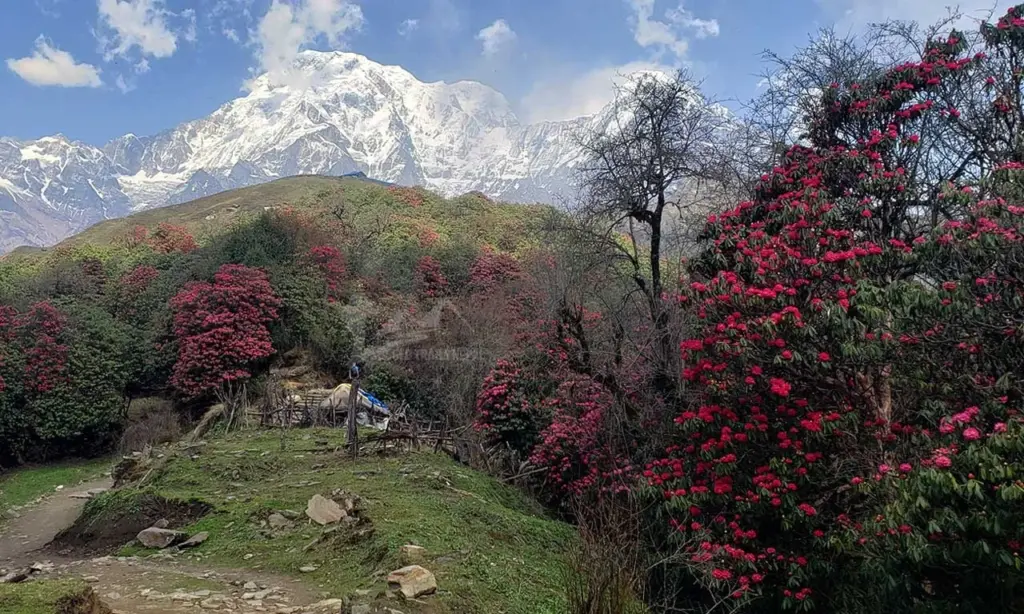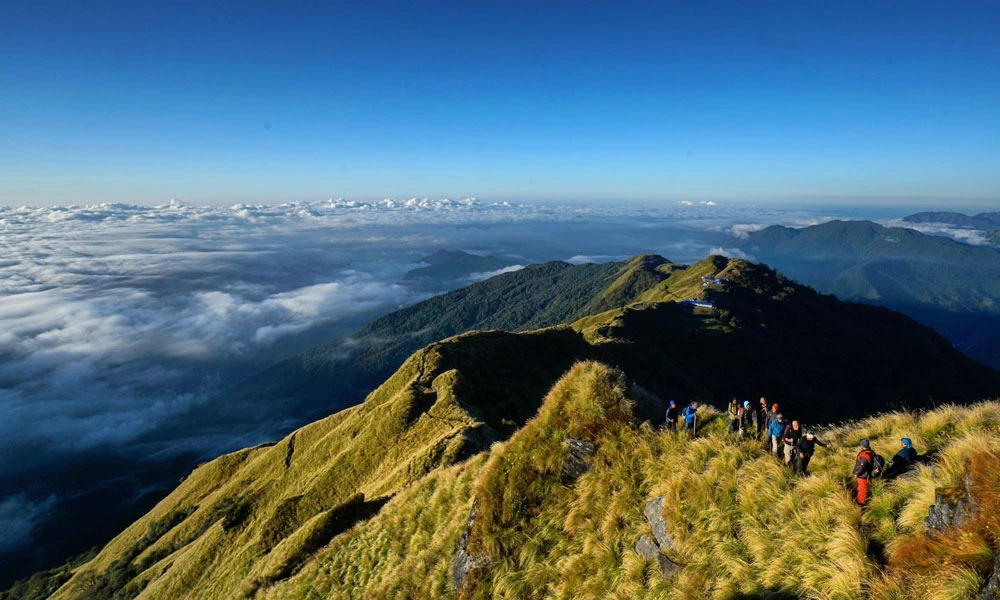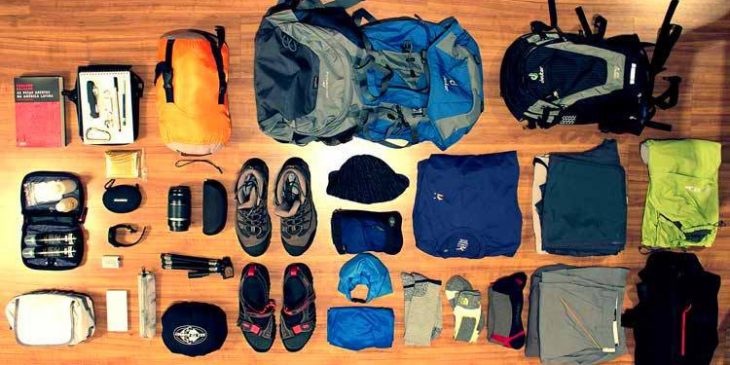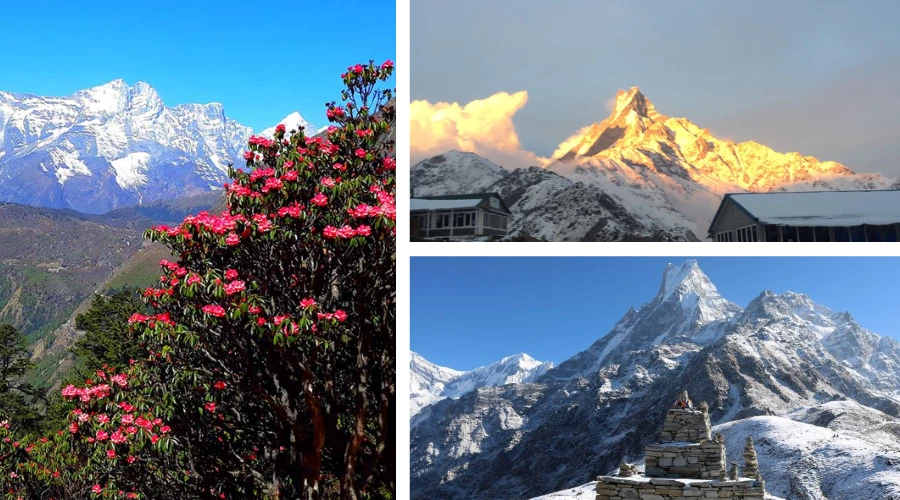Hello, Dear Trekkers!
Looking for a short yet stunning Mardi Himal trek in Nepal, but confused about how to start planning?
Why not begin by learning about the Mardi Himal weather and the best time for Mardi Himal Trek?
The climate in the Mardi Himal region can be broadly categorized into four distinct seasons. Each season offers a unique experience, and understanding these can help you plan your trek more effectively. Sometimes, the Mardi Himal weather can change unpredictably.
Knowing the particular challenges and rewards of each season will allow you to choose the best time for Mardi Himal trek, balancing weather conditions, crowd levels, and personal preferences.
Spring Season (March to May) – Best Time for Mardi Himal Trek in Nepal

Spring is one of the most popular times to visit the Mardi Himal region for trekking. The weather during this period is generally moderate, with daytime temperatures ranging from 10°C to 20°C. The rhododendron forests are in full bloom, painting the trails with vibrant colors. However, the nights can be chilly, so packing warm clothing is essential.
Ideal Trekking Conditions in Spring
Spring offers some of the most favorable Mardi Himal weather conditions. The mild temperatures make it comfortable to hike during the day, while the cool nights provide a refreshing contrast.
As the snow melts, the trails become more accessible, attracting trekkers from around the world. Clear skies often prevail, providing stunning views of the surrounding peaks.
Blooming Rhododendrons and Natural Beauty
Spring offers one of the most favorable Mardi Himal weather conditions for rhododendrons to bloom. Rhododendron is the national flower of Nepal.
One of the standout features of spring is the explosion of color from the blooming rhododendrons. These vibrant flowers create a picturesque backdrop, making the trek even more enchanting. The forests come alive with a variety of flora, offering nature lovers a feast for the senses.
What to Pack for Spring Treks
Daytime conditions are pleasant; however, nighttime temperatures can drop significantly. It’s crucial to bring adequate warm clothing, including thermal layers and a good-quality sleeping bag, along with other trekking gear. Being prepared for the cooler temperatures will ensure you stay comfortable and enjoy restful nights under the stars.
Autumn Season (September to November) – Best Season for Mardi Himal Trek

Autumn is undeniably the best time for Mardi Himal trek. During the autumn season, the Mardi Himal weather is stable, with clear skies and spectacular mountain views. Daytime temperatures hover around 10°C to 18°C, making it comfortable for trekking while enjoying the pleasant scenic beauty of nature.
However, the nights are cooler, but with the right gear, including a warm thermal layer, it’s manageable. This season attracts many trekkers, so you can expect some company on the trails.
Perfect Mardi Himal Base Camp Weather and Clear Mountain Views
Autumn offers the most stable Mardi Himal Base Camp weather conditions for trekking. The skies are normally clear, providing unobstructed views of the majestic mountains, including Annapurna, Machhapuchhre (Fishtail), and Nilgiri. This season is known for its dry weather, making trails more accessible and reducing the risk of landslides or any other weather-related issues.
A Photographer’s Dream Season
The crisp autumn air enhances the clarity of the landscape, making it a photographer’s dream. The golden hues of the forests and the snow-capped peaks create a stunning contrast, perfect for capturing unforgettable memories.
Every corner of the trail presents a new opportunity for breathtaking photographs. Moreover, the golden hour views during the sunrise and sunset are indescribable, offering one of the most delightful contrasts of mountains, clouds, and the golden rays of the sun.
Social and Cultural Encounters on the Trail
As one of the most popular trekking seasons, autumn attracts a diverse group of adventurers. This creates a vibrant social atmosphere on the trails, offering a platform where trekkers can share experiences, stories, and tips. It’s an excellent opportunity to meet fellow travelers, forge lasting friendships, and build up networking.
Winter Season (December to February) – Underrated Yet Best Time to Visit Mardi Himal Base Camp

Winter in the Mardi Himal region is characterized by cold temperatures and occasional snowfall. Daytime temperatures can drop to 5°C, with nighttime temperatures plunging below freezing. As the trails are filled with snow, you can expect the route to be less crowded; however, the snow-capped mountains offer a stunning backdrop.
The winter trek is only recommended for experienced trekkers. It’s essential to be well-prepared for the cold if you choose to trek during this time.
The Beauty of a Winter Trek
For those who enjoy the solitude of a winter landscape, this season offers a unique experience. The cold air is invigorating, and the snow-covered trails provide a serene and peaceful environment.
Trekking in such pleasant Mardi Himal weather conditions is challenging yet one of the most rewarding trekking experiences of your life. However, proper gear is crucial to prevent hypothermia and ensure a safe trek.
Snowy Landscapes and Breathtaking Views
Underrated yet the best time for Mardi Himal trek, the winter months transform this heavenly paradise into a winter wonderland. The snow-draped peaks and frozen landscapes offer some of the most spectacular views in the region. This season is ideal for photographers and those seeking a tranquil escape from the busy trekking seasons.
Essential Winter Trekking Gear
Due to the harsh conditions, preparation is key for the safe and successful Mardi Himal trek. Trekkers must pack appropriately, including layering thermal clothing and carrying adequate supplies for warmth.
A reliable sleeping bag, insulated boots, and trekking poles are essential. With the right preparation, winter treks can be both safe and exceptionally rewarding. As the Mardi Himal Base Camp weather is unpredictable, you can expect sudden and heavy snowfall, making the visibility difficult. So, make sure to carry a map, which can assist in navigating the path.
Monsoon Season (June to August)

The monsoon season brings heavy rainfall to the region, making the trails slippery and challenging. Daytime temperatures can range from 15°C to 25°C, but the humidity levels are high.
This season is one of the least recommended seasons for trekking. However, if you decide to trek during this period, be prepared for leeches and occasional landslides. On the upside, the landscape is lush and green, and the trails are less crowded.
Challenges and Rewards of Monsoon Trekking
The monsoon transforms the trails into a challenging but rewarding adventure. With heavy rains making paths slippery, trekkers need to be cautious and well-prepared. Carrying waterproof gear and sturdy boots is essential to navigate the wet and often muddy terrain safely.
Lush Green Landscapes and Wildlife
The increased moisture brings the landscape to life, offering an opportunity to see a different side of the Himalayas. The dense greenery and blooming flowers attract various wildlife species.
Birdwatchers and nature enthusiasts will find this season particularly rewarding, as the forest teems with life. For photography enthusiasts, this Mardi Himal weather offers you an unforgettable photography experience of nature, birds, and wildlife.
Tips for a Comfortable Monsoon Trek
The high humidity levels can be uncomfortable for some trekkers, necessitating the need for breathable clothing. Additionally, trekkers should be prepared to encounter leeches and other insects. Carrying insect repellent and wearing long sleeves and pants can help minimize bites and stings, ensuring a more comfortable experience.
Also, make sure to carry waterproof gear to keep your essentials and yourself dry. Moreover, since summer is the off-season, most of the accommodations remain closed. So, contact in advance for the stay, or carry all necessary camping gear.
Essential Packing List for Mardi Himal Trek in Nepal

Apart from learning about the Mardi Himal weather or the best season for Mardi Himal trek, it is equally crucial to learn about all the essentials you need to carry during the trek. Packing smartly is key to a successful trek. Here’s a list of essentials you should consider:
- Clothing: Layering is crucial. Pack thermal wear, a down jacket, waterproof outer layers, and warm gloves and hats.
- Footwear: Invest in sturdy, waterproof hiking boots with good grip.
- Backpack: A comfortable backpack with a rain cover is essential to carry your gear.
- Sleeping Bag: A good-quality sleeping bag rated for cold temperatures is a must, especially in the colder months.
- First Aid Kit: Include basic medications, blister care, and altitude sickness tablets.
- Trekking Poles: Helpful for balance on uneven terrain.
- Miscellaneous: Sunglasses, sunscreen, water purification tablets, and a headlamp.
Additional Packing Tips
Layering is the key to adapting to the changing Mardi Himal weather conditions during the trek. Starting with thermal wear as a base layer, you can add or remove layers as needed to stay comfortable. High-quality waterproof hiking boots are essential for navigating rocky and slippery terrain. Don’t forget to pack warm gloves and hats to protect yourself from the cold, especially in higher altitudes.
Your backpack should be lightweight yet durable, with enough space to carry all your essentials. A rain cover is also necessary to protect your belongings and keep them dry from sudden downpours. Investing in a high-quality sleeping bag rated for cold temperatures will ensure you stay warm during chilly nights, especially if you’re trekking in the winter months.
A well-equipped first aid kit is indispensable for addressing common trekking ailments such as blisters, minor injuries, and altitude sickness. Trekking poles provide much-needed support on uneven ground, reducing the risk of slips and falls. Additionally, carrying sunglasses and sunscreen will protect you from the intense sun at high altitudes, while water purification tablets ensure access to safe drinking water.
A headlamp is crucial for navigating in low-light conditions, whether you’re starting your trek early in the morning or setting up camp at dusk. Other useful items include a multipurpose tool, a map or GPS device, and a camera to capture the stunning landscapes. Packing smartly and efficiently will enhance your trekking experience, allowing you to focus on the journey ahead.
Important Trekking Tips for Mardi Himal Trek in Nepal

- Acclimatize Properly: Spend a day or two at lower altitudes to adjust to the thinner air.
- Stay Hydrated: Drink plenty of water to prevent altitude sickness.
- Hire a Guide: A local guide can enrich your experience with insights about the region and ensure your safety.
- Respect the Environment: Follow the Leave No Trace principles to preserve the natural beauty of the Himalayas.
- Stay Informed: Check the weather forecasts regularly and adjust your plans accordingly.
Acclimatization and Hydration
Proper acclimatization is crucial to avoid altitude sickness. Spending an extra day at a lower altitude allows your body to adjust to the reduced oxygen levels. It’s equally important to stay hydrated, as dehydration can exacerbate altitude-related symptoms. Drinking at least three to four liters of water daily will help maintain your energy levels and prevent headaches.
Benefits of Hiring a Local Guide
A local guide is invaluable for navigating the trails and gaining deeper insights into the region’s culture and history. Guides are familiar with the terrain and can offer advice on the best routes for Mardi Himal Trek, ensuring a safer trek. Additionally, they can assist in emergencies, providing peace of mind as you explore the wilderness.
Practicing Eco-Friendly Trekking
The pristine environment of the Himalayas is a precious resource that deserves protection. Adhering to the Leave No Trace principles means minimizing your impact on the landscape, including proper waste disposal and respecting wildlife. By trekking responsibly, you contribute to the preservation of this beautiful region for future generations.
Staying Updated on Mardi Himal Weather Conditions
Mardi Himal Base Camp weather conditions can change rapidly, so staying informed is vital. Regularly checking weather forecasts enables you to make informed decisions about your trek, such as adjusting your itinerary if necessary. Flexibility in your plans allows you to adapt to changing conditions, ensuring a safer and more enjoyable experience.
Final Thoughts
The Mardi Himal Trek is an unforgettable journey through one of the most beautiful landscapes on Earth. By understanding the Mardi Himal weather patterns and preparing accordingly, you’ll ensure a safe and enjoyable trek. Whether you’re exploring the vibrant flora of spring, the lush greenery of monsoon, the clear vistas of autumn, or the snowy serenity of winter, each season offers its own unique charm. So, pack your bags, and get ready to create memories that will last a lifetime on the Mardi Himal trekking in Nepal.
With the right preparation and mindset, the Mardi Himal Base Camp trek will not only challenge you but also reward you with experiences and views that are nothing short of spectacular. Make sure to choose the best season for Mard Himal Trek.
Happy trekking!
FAQs
1. What is the climate in Mardi Himal?
The climate of the Mardi Himal depends upon the four distinct seasons. During the daytime in the peak seasons like spring and autumn the temperature remains moderate at 12−18°C and night is quite chilly at 2−8°C. However, during the winter season the temperature remains cold, dropping below the freezing point at nighttime.
2. Which month is best for Mardi Himal Trek?
The Mardi Himal trek is a short trek near Pokhara, which is favorable almost every season. However, the best time for Mardi Himal trek are March to May in spring and September to November in autumn. As, during these months, the Mardi Himal weather is clear and the temperature is moderate making the most favorable time to trek while witnessing the majestic vista of mountains and lush forests.
3. How difficult is Mardi Himal Trek in Nepal?
One of the short treks in Nepal, the Mardi Himal trekking difficulty level is easy to moderate. This trail is suitable for both beginner as well as advanced trekkers. If you are short with time, you can easily complete this trek in a short schedule.
4. Is Mardi Himal safe?
Yes, with a proper established route and easy trails to walk, the Mardi Trek is one of the safest trekking routes in Nepal but make sure you are traveling with a registered trekking agency in Nepal.
5. Which month is best for snowfall?
Generally, the best months for snowfall in the Mardi Base as well as High Camp is during the winter season between December to February. However, the spring and autumn also might face slight snowfall.
6. Do I need a permit for Mardi Himal Trek in Nepal?
Yes, you need to carry three essential permits while trekking to Mardi Himal:
– TIMS Card
– Annapurna Conservation Area Permit (ACAP)
– A Local Permit
7. How high is Mardi Himal?
The Mardi Himal is 5,587 m tall standing proudly just beneath the Machhapuchhre (Fishtail) Mountain in the Annapurna Region, Nepal.
